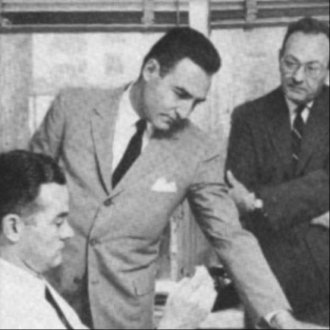
 John Wiley Hill, president of Hill & Knowlton, Inc. wrote chapter six in the 1948 US book, edited by Glenn and Denny Griswold, Your Public Relations (being serialised here with monthly posts) – to read other chapters in our series of posts, use this link to the book’s contents list.
John Wiley Hill, president of Hill & Knowlton, Inc. wrote chapter six in the 1948 US book, edited by Glenn and Denny Griswold, Your Public Relations (being serialised here with monthly posts) – to read other chapters in our series of posts, use this link to the book’s contents list.
By 1948 Hill had over two decades’ experience in PR (following 18 years as a journalist and financial editor), which he entered as a consultant setting up a firm in Cleveland Ohio. In 1933, he brought on board Donald Knowlton (the PR director of a banking client that had closed in the Depression), and the next year opened an office in New York City. As Karen Miller Russell writes in the Encyclopedia of Public Relations, Hill & Knowlton became “the largest and most successful public relations firm in history” leading the industry in billings for about 30 years after World War II, and expanding into Europe in 1952 and then into other international markets. Hill remained active in public relations until shortly before his death in 1977.
How to use Public Relations counsel by John Wiley Hill, President, Hill & Knowlton, Inc. (written in 1948)
The profession of public relations counselling originally grew out of press-agentry – probably circus press-agentry, at that. And for a long while it grew slowly. Ivy Lee, whose latter career was built on his earlier work for the Pennsylvania Railroad and the Rockefellers, is credited with the original formulation of principles that brought to him recognition – before his death in 1935 – as the first public ratlins counsellor of his day.
One of those principles is this: A large corporation nowadays needs far more than a profitable sales record for continuity of its prosperity. It must above all enjoy a climate of public opinion that is favorable to its operations. The big utilities felt fairly prosperous in the twenties; but that economic fact did not protect them from the anti-utilitary legislation of a Congress egged on by hostile voters.
Neither a prosperous earning record nor a dominant position in the market can raise a company above the need for friendly public attitudes. Indeed, the larger a corporation grows, the more exposed it may become to the dangers of possible public disapproval. The legislative history of recent years has helped to underline this fact.
Functions of Public Relations Counsel
Hill outlines the function of public relations counsel is to help “stimulate and maintain” public attitudes necessary for the continuing success of an enterprise calling it “creative work” which has grown enormously “in a period of world war and world revolution”. He notes:
But while the number of workers in the field of press-agentry and product promotion is now almost legion – for the opportune methods of publicity can be readily grasped – there are still relatively few specialists in the principles of corporate and industrial public relations.
The chapter focuses on “the work of the professional public relations firm” outlining three key advantages:
- Experience in many different fields – arguing that this, ensures “to the counsellor with adequate background and experience, no problem can be quite unique and precedented.”
- Independence of judgement
- A team of specialists – saying the “day of the public relations ‘genius’ who knows all the answers has passed” owing to the complexity of “the public relations problems of modern industry”.
Hill emphasises that this last point “does not in any sense mean the passing of the close and intimate personal relationship between counsel and client. It merely means that the client has a pool of specialized talent and experience on which to draw, in meeting special problems as they arise”. He argues the role of the PR counsel is “not to command, but to suggest”, stating:
Management could not delegate to him, or to anyone else – even if it wished – the responsibility for the company’s public relations. Public relations is so much a part of policy that to delegate its conduct would be to abrogate management itself.
The chapter continues by outlining “hardly a move can be made by a modern corporation without involving some public reaction”, with Hill stating that “even though basic policy decisions are clearly management’s prerogative, wise management weighs every possible public retains when each decision is made.” He then develops how the public relations counsel brings an “independent and objective viewpoint” to be “of vital use to corporation officers”, arguing against regarding PR “as only a kind of product promotion” or as a “device for making a ‘good story’ out of whatever may transpire”:
Stories woven of tinsel soon tarnish. Those that are whitewash leave telltale streaks after rain.
Hill says: “It is the first business of the public relations counsel to help management achieve public relations policy decisions that are sound and in the public interest” contrasting PR with legal counsel which is guided by a legal code “which reflects the long-crystallized sentiments of society”, as the PR counsel is “especially concerned with the public moods and sentiments as a current development, long before they are codified or crystallized. This is one reason his knowledge is not to be found accumulated in abstract texts. Whereas a lawyer focuses on the certainties of yesterday as a guide to today, the wise public relations counsellor is guided by judgments regarding the probabilities of tomorrow.”
Must Combine Many Skills
His lore is even more scientific than that of the lawyer. It stems from sciences as various as psychology, sociology, economics, biology; from arts as different as writing and the handling of men. It is merely unmodified, as it perhaps must be, by its nature. As yet it is not adequately taught. There are a few college ‘public relations courses’ of some academic merit, but there is no generally accepted procedure through which a young man may acquire adequate training in both the theory and practice of public relations as a career.
No profession today calls for more basic understanding of the complex laws that lie behind the workings of our economy, the development of public opinion, the shifts in political trends, the changing attitudes that work to revolutionize the meaning and status of institutions in our society. Public relations problems are interwoven with all the complex and difficult problems of our times.














